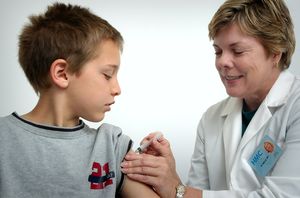Vaccines
This article or area is currently under construction and may only be partially complete. Please come back soon to see the finished work! (6/06/2020)
Original Editor - Lucinda hampton
Top Contributors - Lucinda hampton, Sukhi Dhaliwal, Kim Jackson, Kirenga Bamurange Liliane and Nupur Smit Shah
Introduction[edit | edit source]
Vaccination is one of the most effective ways to prevent diseases. Vaccines protect against more than 25 debilitating or life-threatening diseases, including measles, polio, tetanus, diphtheria, meningitis, influenza, tetanus, typhoid and cervical cancer.[1]
A vaccine is a pharmacologic compound that improves a person's immunity to a particular disease.
- When a disease-causing bacterium or virus invades the human body, the immune system recognizes the material as foreign, usually by detecting specific protein portions of the invading organism, known as antigens.
- Vaccines contain a form of the disease-causing agent, whether it be a weakened or killed form of the microbe itself, an inactivated version of its toxins, or a protein from the surface of the microbe.
- By introducing a form of the agent, the vaccine presents the antigen to the immune system, allowing it to recognize the antigen as foreign and develop antibodies and memory T-lymphocytes against those antigens.
- This allows a more rapid and robust immune response should the body be exposed to the organism in the future.
- In the absence of vaccination, the first exposure to the natural organism may prove fatal before the immune system can mount a sufficient immune response.[2]
Currently, the majority of children receive their vaccines on time. However, nearly 20 million worldwide still miss out – putting them at risk of serious diseases, death, disability and ill health.[1]
Developing A New Vaccine[edit | edit source]
The general stages of the development cycle of a vaccine are:
- Exploratory stage
- Pre-clinical stage
- Clinical development - 3 phase process. During Phase I, small groups of people receive the trial vaccine. In Phase II, the clinical study is expanded and vaccine is given to people who have characteristics (such as age and physical health) similar to those for whom the new vaccine is intended. In Phase III, the vaccine is given to thousands of people and tested for efficacy and safety.
- Regulatory review and approval
- Manufacturing
- Quality control[3]
The 4.5 minute video below is an interesting watch
Sub Heading 3[edit | edit source]
Resources[edit | edit source]
- bulleted list
- x
or
- numbered list
- x
References[edit | edit source]
- ↑ 1.0 1.1 WHO Vaccines Available from:https://www.who.int/topics/vaccines/en/ (last accessed 6.6.2020)
- ↑ Ginglen JG, Doyle MQ. Immunization. InStatPearls [Internet] 2018 Oct 27. StatPearls Publishing. Available from:https://www.ncbi.nlm.nih.gov/books/NBK459331/ (last accessed 6.6.2020)
- ↑ CDC Vaccines Available from:https://www.cdc.gov/vaccines/basics/test-approve.html (last accessed 6.6.2020)
- ↑ Youreka Vaccine clinical trial Available from:https://www.youtube.com/watch?v=R4AUGdT3DE8&app=desktop (last accessed 6.6.2020)







